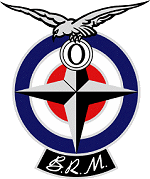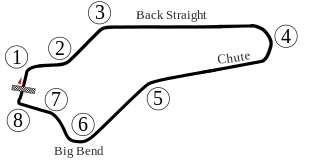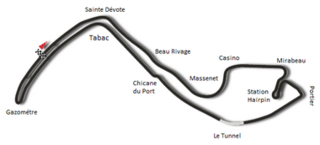
British Racing Motors (BRM) was a British Formula One motor racing team. Founded in 1945 and based in the market town of Bourne in Lincolnshire, it participated from 1951 to 1977, competing in 197 grands prix and winning seventeen. BRM won the constructors' title in 1962 when its driver Graham Hill became world champion. In 1963, 1964, 1965 and 1971, BRM came second in the constructors' competition.

The 1966 United States Grand Prix was a Formula One motor race held on October 2, 1966, at the Watkins Glen Grand Prix Race Course in Watkins Glen, New York. It was race 8 of 9 in both the 1966 World Championship of Drivers and the 1966 International Cup for Formula One Manufacturers. The race was the ninth United States Grand Prix. It was the sixth to be held at Watkins Glen. The race was held over 108 laps of the 3.78-kilometre circuit for a total race distance of 408 kilometres.

The 1967 Monaco Grand Prix was a Formula One motor race held at Monaco on May 7, 1967. It was race 2 of 11 in both the 1967 World Championship of Drivers and the 1967 International Cup for Formula One Manufacturers, albeit four months after Pedro Rodríguez's unexpected victory at Kyalami. The 100-lap race was won by Brabham driver Denny Hulme after he started from fourth position. Graham Hill finished second for the Lotus team and Ferrari driver Chris Amon came in third.

The 1967 German Grand Prix was a motor race for both Formula One and Formula Two cars held at the Nürburgring on 6 August 1967. It was race 7 of 11 in both the 1967 World Championship of Drivers and the 1967 International Cup for Formula One Manufacturers as well as race 3 of 10 of the 1967 European Formula Two Championship. The 15-lap race was won by Brabham driver Denny Hulme after he started from second position. His teammate Jack Brabham finished second and Ferrari driver Chris Amon came in third.

The 1968 Spanish Grand Prix was a Formula One motor race held at Jarama Circuit on 12 May 1968. It was race 2 of 12 in both the 1968 World Championship of Drivers and the 1968 International Cup for Formula One Manufacturers. It was the first race after the death of former double World Champion Jim Clark, who had died in a non-championship Formula Two event in Hockenheim, Germany the previous month. Clark had led the drivers' championship before this race, on 9 points, after he won in the first race in South Africa.

The 1968 Monaco Grand Prix was a Formula One motor race held at the Monte Carlo Circuit on 26 May 1968. It was race 3 of 12 in both the 1968 World Championship of Drivers and the 1968 International Cup for Formula One Manufacturers. The race was won by Lotus driver Graham Hill, who started from pole position. Richard Attwood, driving for BRM, gained second place and fastest lap, while Lucien Bianchi finished in third position in a Cooper, in what was to be these two drivers' only podium finishes.

The 1968 Italian Grand Prix was a Formula One motor race held at the Monza Autodrome on 8 September 1968. It was race 9 of 12 in both the 1968 World Championship of Drivers and the 1968 International Cup for Formula One Manufacturers. The 68-lap race was won by McLaren driver Denny Hulme after he started from seventh position. Johnny Servoz-Gavin finished second for the Matra team and Ferrari driver Jacky Ickx came in third.

The 1968 Canadian Grand Prix was a Formula One motor race held at the Circuit Mont-Tremblant in St. Jovite, Quebec, Canada on September 22, 1968. It was race 10 of 12 in both the 1968 World Championship of Drivers and the 1968 International Cup for Formula One Manufacturers. The 90-lap race was won by McLaren driver Denny Hulme after starting from sixth position. Hulme's teammate Bruce McLaren finished second and BRM driver Pedro Rodríguez came in third.

The 1969 United States Grand Prix was a Formula One motor race held on October 5, 1969, at the Watkins Glen Grand Prix Race Course in Watkins Glen, New York. It was race 10 of 11 in both the 1969 World Championship of Drivers and the 1969 International Cup for Formula One Manufacturers. The 108-lap race was won by Lotus driver Jochen Rindt after he started from pole position. Piers Courage finished second for the Brabham team and BRM driver John Surtees came in third.

The 1970 Monaco Grand Prix was a Formula One motor race held at the Circuit de Monaco on 10 May 1970. It was race 3 of 13 in both the 1970 World Championship of Drivers and the 1970 International Cup for Formula One Manufacturers. Jochen Rindt scored the last victory for the famous Lotus 49.

The 1971 Formula One season was the 25th season of the Fédération Internationale de l'Automobile's Formula One motor racing. It featured the 22nd World Championship of Drivers and the 14th International Cup for F1 Manufacturers which were contested concurrently over eleven races between 6 March and 3 October. The season also included a number of non-championship races open to Formula One cars.
The 1968 Formula One season was the 22nd season of the FIA's Formula One motor racing. It featured the 19th FIA World Championship, which commenced on 1 January, and ended on 3 November after twelve races, and numerous non-championship races.
The 1961 Formula One season was the 15th season of Formula One motor racing. It featured the 1961 World Championship of Drivers and the 1961 International Cup for F1 Manufacturers, which were contested concurrently from 14 May to 8 October over an eight race series. The season also included numerous non-championship races for Formula One cars.
The 1960 Formula One season was the 14th season of the FIA's Formula One motor racing. It featured the 11th FIA World Championship of Drivers, the third International Cup for F1 Manufacturers and numerous non-championship Formula One races. The World Championship commenced on 7 February and ended on 20 November after ten races. Jack Brabham won his second consecutive title with his Cooper team defending its constructors' title.
Michael Henderson Spence was a British racing driver from England. He participated in 37 Formula One World Championship Grands Prix, debuting on 8 September 1963. He achieved one podium, and scored a total of 27 championship points. He also participated in numerous non-Championship Formula One races, as well as sports car racing.

Richard James David "Dickie" Attwood is a British motor racing driver, from England. During his career he raced for the BRM, Lotus and Cooper Formula One teams. He competed in 17 World Championship Grands Prix, achieved one podium and scored a total of 11 championship points. He was also a successful sports car racing driver and won the 1970 24 Hours of Le Mans race, driving a Porsche 917, the first of Porsche's record 19 victories at the famous race.
Four-wheel drive (4WD) has only been tried a handful of times in Formula One. In the World Championship era since 1950, only eight such cars are known to have been built.

The BRM P261, also known as the BRM P61 Mark II, is a Formula One motor racing car, designed and built by the British Racing Motors team in Bourne, Lincolnshire, England. The BRM P261 was introduced for the 1964 Formula One season, and its design was an evolution of Tony Rudd's one-off BRM P61 car of 1963. The P261 had a relatively long racing career; variants of the car were still being entered for Formula One World Championship Grands Prix as late as 1968. During the course of their front-line career BRM P261s won six World Championship races, in the hands of works drivers Graham Hill and Jackie Stewart, and finished second in both the Drivers' and Constructors' Championship standings in 1964 and 1965. Stewart, Hill and Richard Attwood also used works P261s to compete in the Tasman Series in 1966. The BRMs dominated, with Stewart winning four, Hill two, and Attwood one of the 1966 Tasman Series' eight races. Stewart also won the title. The works-backed Reg Parnell Racing team returned in 1967 with Stewart and Attwood, where Stewart added another two wins to his tally. In terms of races won and total Championship points scored, the P261 was the most successful car in BRM's history.

The Brabham BT3 is a Formula One racing car. It was the first Formula One design to be produced by Motor Racing Developments for the Brabham Racing Organisation, and debuted at the 1962 German Grand Prix. The Brabham BT3 was the vehicle with which team owner – then two-time World Champion – Jack Brabham, became the first driver ever to score World Championship points in a car bearing his own name, at the 1962 United States Grand Prix. The following year Brabham also became the first driver ever to win a Formula One race at the wheel of an eponymous car, again driving the BT3, at the 1963 Solitude Grand Prix. The BT3 design was modified only slightly to form the Tasman Series-specification Brabham BT4 cars.

The BRM P83 was a Formula One racing car designed by Tony Rudd and built by British Racing Motors for the new engine regulations of 1966. It used a highly unorthodox H16 engine which caused problems throughout the car's racing life, and despite the best efforts of Graham Hill and Jackie Stewart took BRM from championship contenders to also-rans, leading it to be regarded alongside the BRM Type 15 as another embarrassing failure for the British marque caused by overcomplicated engineering.














